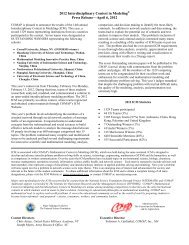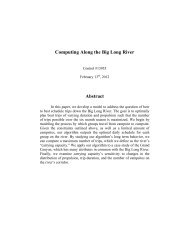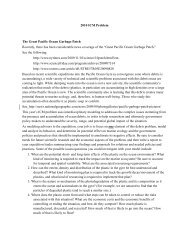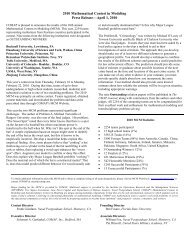Centroids, Clusters and Crime: Anchoring the Geographic Profiles of ...
Centroids, Clusters and Crime: Anchoring the Geographic Profiles of ...
Centroids, Clusters and Crime: Anchoring the Geographic Profiles of ...
Create successful ePaper yourself
Turn your PDF publications into a flip-book with our unique Google optimized e-Paper software.
Team # 7507 Page 9<br />
3.2.3 Single Offender<br />
Finally, we must assume that <strong>the</strong>re is only one actor involved in <strong>the</strong> killings. There is some<br />
leeway, <strong>of</strong> course, in <strong>the</strong> interpretation <strong>of</strong> <strong>the</strong> word “actor”; some sources consider two or more<br />
individuals acting with collective intent to be a single “actor” for <strong>the</strong> purposes <strong>of</strong> geographic<br />
pr<strong>of</strong>iling.[15]. For <strong>the</strong> purposes <strong>of</strong> our model, if multiple individuals committing <strong>the</strong> crimes are<br />
truly acting with <strong>the</strong> same shared mindset, we should be able to project <strong>the</strong>ir next strike with<br />
<strong>the</strong> same level <strong>of</strong> confidence. What is more important to note is that <strong>the</strong> model treats all input<br />
data points as crimes which were definitively committed by <strong>the</strong> same person. Consequently,<br />
it is inadvisable to include a crime which “might have been <strong>the</strong> work <strong>of</strong> <strong>the</strong> serial criminal”<br />
solely for <strong>the</strong> purposes <strong>of</strong> improving statistics.<br />
3.3 Spatial Focus<br />
While some research in <strong>the</strong> temporal patterns <strong>of</strong> serial criminals exists, research seems that <strong>the</strong><br />
best predictor <strong>of</strong> future geographic crime location is past geographic data. Temporal data is<br />
problematic for use in our model for several key reasons.<br />
1. While research has found cyclical patterns within <strong>the</strong> time between crimes, <strong>the</strong>se patterns<br />
don’t correlate directly to predicting <strong>the</strong> next geographic location. What is useful is<br />
general trends in spacial movement over an ordering <strong>of</strong> <strong>the</strong> locations. We will utilize this<br />
in our model by ignoring <strong>the</strong> specific time data that is present in crime sets, using this<br />
information only to develop an ordering within <strong>the</strong> crime sequence itself.<br />
2. For <strong>the</strong> most violent <strong>of</strong> serial crimes (murder, rape/murder), time data can be incredibly<br />
inaccurate. While it is generally good enough to establish an ordering in <strong>the</strong> time sequence,<br />
<strong>the</strong> dates <strong>and</strong> times <strong>of</strong> murders are usually discerned from <strong>the</strong> remnants <strong>of</strong> body<br />
dumps. While rape cases generally have clear time stamps, we use only an ordering <strong>of</strong><br />
<strong>the</strong> data to stay inclusive over <strong>the</strong> set <strong>of</strong> violent crimes which we want our model to<br />
address.<br />
4 Developing a Serial <strong>Crime</strong> Test Set<br />
4.1 The Scarcity <strong>of</strong> Source Data<br />
Finding representative <strong>and</strong> accurate data is a unique challenge within <strong>the</strong> development process<br />
<strong>of</strong> any algorithm. Testing our models accuracy in predicting actual crimes is is an obvious best
















